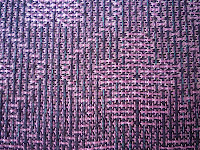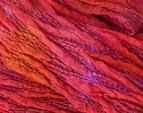Well, winter solstice has been and gone (yesterday) and the day seems longer, maybe that's just because the sky is azure blue and the sun warm.
I figured I had sampled enough to know where I was going so threaded the loom with the threads I'll be using for the finished DPW project.
Warp thick: navy cotton/rayon
Warp thin: violet 20/2 cotton
Weft thick: violet 8/2 cotton
Weft thin: navy cotton, probably 16/2
Threaded and treadled the older way 2 3 2, 1 4 1, 2 5 2, 1 6 1 etc If I try this again I think I'd use 12 3, 12 4, 12 5, 12 6 etc as more versatile and blockier.
Tried 12 dent reed, 36 epi and a mock up of 10 dent reed, 30 epi but still felt like hard cardboard.
Rethreaded to 8 dent reed, 24 epi, and its much better but then, of course, the proportion of the flowers (do they look like cherry blossom to you) was way off, short and squat. A couple of hours on PCW fiberworks last night and we're away.
This wee bit at the top used a black thin weft to save on the navy I will use. See how squat the blossom is compared to what's on the loom. (The light/darker area is where the loom apron begins.)
Close up of fabric. As I've never seen DPW in reality can anyone tell me if this looks like it should.








_flower.JPG)






